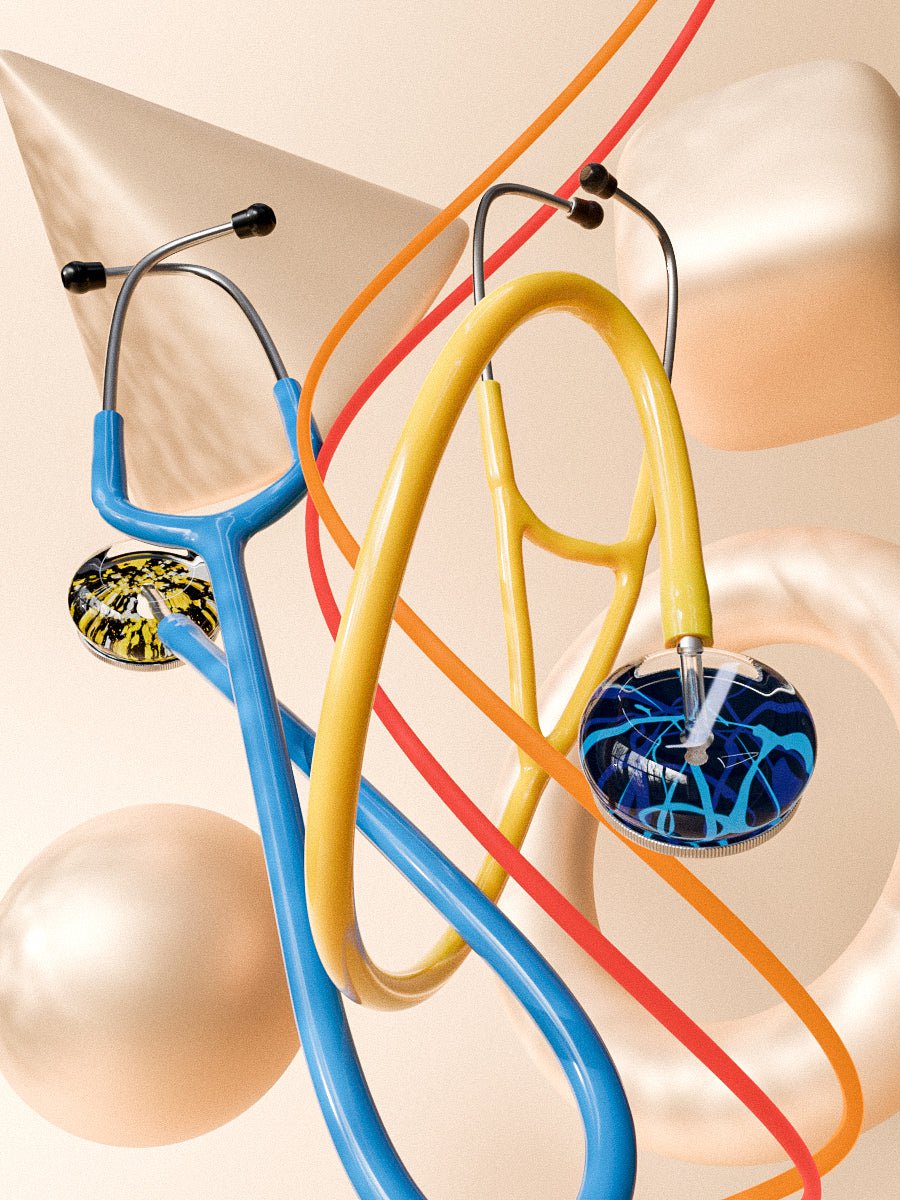A stethoscope is an instrument used by medical professionals, nurses and nursing students for hearing internal sounds produced by the heart, intestines, lungs, and blood flow in the arteries and veins. A stethoscope can be used on animals or human beings. Medical professionals are taught how to use stethoscopes but you too can learn how to use a stethoscope and use it on yourself.
Why Do Medical Professionals Use Stethoscopes?
Depending on the problem a patient has shared with a doctor or nurse, the doctor might be looking for abnormal sounds in the heart or lungs. He or she is looking for a lub dub sound in the heart which is the normal sound that the heart is supposed to produce. However, sometimes, the doctor may hear a whooshing sound instead and in that case, the patient will need further examination.
In the lungs, the doctor expects to hear a normal breathing sound which sounds like someone breathing into a cup. If the doctor doesn’t hear the normal sound, wheezing or crackling sounds may be heard and this might indicate that the lungs of the patient are not healthy.
Parts of a Stethoscope
Before even getting to know how a stethoscope works, it’s important to know the basic parts that make a stethoscope. They include:
- Diaphragm - this is the circular metallic part at the end of the stethoscope that picks up low-pitched sounds.
- Bell - this is the smaller part on top of the diaphragm that picks up high-pitched sounds.
- Tubing - this is the tube through which sounds pass from the diaphragm to the earpieces.
- Aural tubes - these are the tubes in the middle of the earpieces and the tubing through which low-frequency sounds pass.
- Earpieces - these are the small pieces at the tip of the stethoscope which prevent external noises from being heard and they receive the sound from the diaphragm.
How to Use a Stethoscope
The only way you can use a stethoscope effectively is when you understand the meaning of the different sounds you hear. Below are important things to know before using a stethoscope.
- First, use a high-quality stethoscope because the better the quality of the stethoscope the better the chances of hearing well. Single tubed stethoscopes are more preferred than double tubed ones because the tubes in the double tubed stethoscope, have a chance of rubbing against each other making it impossible for you to hear the sound correctly. Also, if you tap the diaphragm and you are not able to hear any sound, probably the tube has a leak.
- The other important factor is that the earpieces should face in front and fit in the ears well, if not, you won’t hear the sounds accurately. Also, check the earpiece’s tension and make sure they are not too tight or too loose because it affects whether you will hear or not.
- Choose the correct chest piece for yourself based on the purpose to which you are using it. They are in distinct sizes for kids and grown-ups.
- Find a serene environment where you can hear well without any external distractions from background noises.
- Make sure you use the stethoscope on bare skin to get accurate results.
There are several ways in which you can use the stethoscope:
Listening to the heart
- If you are listening to the heart, place the diaphragm on the left upper part of the chest where the 4thand 6th ribs connect. Hold the stethoscope between your pointing finger and middle fingers and apply light pressure.
- Pay attention to the heart’s beat for a whole one minute. Breathe normally and you should be able to hear normal sounds from the heart.
- Calculate the number of heartbeats you hear per minute. The normal heart rate for an adult or child above 10 years is 60-100 beats per minute.
- The normal resting heart rate for well-trained athletes is 40-60 beats per minute.
- As you count the number of heartbeats, also listen for any abnormal sounds. Anything apart from a lub dub is an abnormal sound.
- If you hear a whooshing sound, then you might be going through a heart murmur which is a condition that results from blood rushing fast through the valves. In such a case, you should seek medical advice from a doctor.
Listening to the Lungs
- Sit in an upright position and breathe in and out as usual and position the stethoscope on the upper part of the chest, shift to the midclavicular line of the chest and finally move it to the lower side of the chest.
- Listen for normal sound breaths which sound like someone blowing into a cup.
- Listen for abnormal sounds like wheezing, stridor sounds, rhonchi, and rales sounds. Wheezes are heard when the airways are squeezed and crackles occur when there is some fluid in the lungs.
- Wheezing is the high-pitched sound produced by someone who has asthma and is heard when a person breathes out and sometimes when they inhale. You don’t necessarily require to use a stethoscope to hear the wheezing sounds they are noticeable even without a stethoscope.
- Stridor sounds are high-pitched sounds similar to wheezing caused by a blockage at the back of the throat.
- Rhonchi sounds are sounds like snoring which come about when air has followed through a blocked path.
- Rales sounds can be compared to sounds made when someone pops a bubble wrap and they are heard when a person inhales. This sound is heard when there is congestion in the lungs.
Listening to Abdominal Sounds
- Position the diaphragm on the stomach and using the belly button as the center, listen to the upper right and left and the lower right and left of the stomach.
- Listen for normal bowel sounds like growling and grumbling. Anything apart from that is an abnormal sound.
- If you don’t hear any sounds, it may indicate constipation. For constipation however, grumbling sounds should return normally but if they don’t, that means that there might be a blockage in the stomach and therefore you should seek medical attention.
- If there are high-pitched bowel sounds, that means that there is a barrier in the bowel.
- If you hear extremely active bowel sounds followed by no bowel sounds that means that there has been a rapture in the bowel tissue.
- If you hear slow bowel sounds, that may be due to prescription drugs, trauma, abdominal surgery, over expansion of the bowel, or an infection.
Listening for a bruit
- If you suspect that you have a heart murmur, you should examine if you have a bruit since they are similar.
- To check for a bruit, on the carotid arteries, position the diaphragm over one of the carotid arteries which is found in front of the neck on either side of the Adam’s apple.
- A bruit produces a whooshing sound and that shows that the artery is blocked, when one has a bruit, the whooshing sound is louder than that of a heart murmur.
Warnings
- Exposing the stethoscope to water or heat may damage it.
- Talking into the drum loudly or tapping hard on it may cause damage to your ears.
- Bending your stethoscope too much may damage it. Also, don’t insert the stethoscope into your pocket because you risk spoiling the tubes or getting the earpieces dirty.
How to Clean Your Stethoscope
After using your stethoscope, cleaning it is very important. Never submerge your stethoscope inside any liquid solution to clean it, you will spoil it. The proper way of cleaning a stethoscope is by using 70% isopropyl alcohol wipes or cotton balls. Tubes get stiff as the years go by, as a result of coming into contact with skin oils. If this happens, it is normal and you shouldn’t try to soften them but rather replace them.
Now that you know how to use a stethoscope on your own, if you hear any abnormal sounds, seek medical advice immediately.





